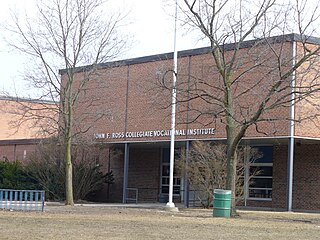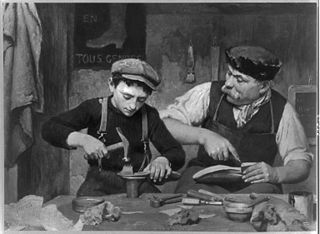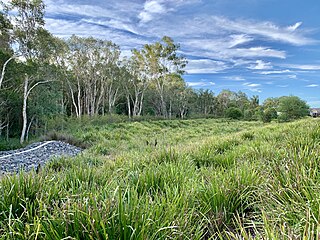Technical and further education or simply TAFE is the common name in Australia for vocational education, as a subset of tertiary education. TAFE institutions provide a wide range of predominantly vocational courses. Colloquially also known as "Tech".

Vocational education is education that prepares people for a skilled craft. Vocational education can also be seen as that type of education given to an individual to prepare that individual to be gainfully employed or self employed with requisite skill. Vocational education is known by a variety of names, depending on the country concerned, including career and technical education, or acronyms such as TVET and TAFE.

Apprenticeship is a system for training a new generation of practitioners of a trade or profession with on-the-job training and often some accompanying study. Apprenticeships may also enable practitioners to gain a license to practice in a regulated occupation. Most of their training is done while working for an employer who helps the apprentices learn their trade or profession, in exchange for their continued labor for an agreed period after they have achieved measurable competencies.
A journeyman is a worker, skilled in a given building trade or craft, who has successfully completed an official apprenticeship qualification. Journeymen are considered competent and authorized to work in that field as a fully qualified employee. They earn their license by education, supervised experience and examination. Although journeymen have completed a trade certificate and are allowed to work as employees, they may not yet work as self-employed master craftsmen.

The University of Southern Queensland is a public research university based in Toowoomba, Queensland, Australia, the sixth largest city in the Australian state of Queensland Founded in 1967 after a successful campaign by the local Darling Downs community, the university is a founding member of the Regional Universities Network.

A vocational school, trade school, or technical school is a type of educational institution, which, depending on the country, may refer to either secondary or post-secondary education designed to provide vocational education or technical skills required to complete the tasks of a particular and specific job. In the case of secondary education, these schools differ from academic high schools which usually prepare students who aim to pursue tertiary education, rather than enter directly into the workforce. With regard to post-secondary education, vocational schools are traditionally distinguished from four-year colleges by their focus on job-specific training to students who are typically bound for one of the skilled trades, rather than providing academic training for students pursuing careers in a professional discipline. While many schools have largely adhered to this convention, the purely vocational focus of other trade schools began to shift in the 1990s "toward a broader preparation that develops the academic" as well as the technical skills of their students.

Capalaba is an urban locality in the City of Redland, Queensland, Australia. In the 2021 census, Capalaba had a population of 18,002 people.

Tewantin is a town and locality in the Shire of Noosa, Queensland, Australia. Tewantin was the original settlement in the Noosa region and is one of its three major centres today. In the 2021 census, the locality of Tewantin had a population of 11,164 people.

South East Queensland (SEQ) is a bio-geographical, metropolitan, political and administrative region of the state of Queensland in Australia, with a population of approximately 3.8 million people out of the state's population of 5.1 million. The area covered by South East Queensland varies, depending on the definition of the region, though it tends to include Queensland's three largest cities: the capital city Brisbane; the Gold Coast; and the Sunshine Coast. Its most common use is for political purposes, and covers 35,248 square kilometres (13,609 sq mi) and incorporates 11 local government areas, extending 240 kilometres (150 mi) from Noosa in the north to the Gold Coast and New South Wales border in the south, and 140 kilometres (87 mi) west to Toowoomba. It is the third largest urban area in Australia by population.
Southern Queensland Institute of TAFE (SQIT) is an Australian vocational college for teaching Tertiary and Further Education. The Institute provides training across a significant portion of Southern Queensland with campuses in Toowoomba, Roma, Warwick, Kingaroy, Dalby, Chinchilla, Charleville, Cherbourg and Stanthorpe.
Australian Technical Colleges (ATCs) were a class of Australian senior secondary school funded by the Australian federal government between 2005 and 2009. The Australian Technical College program ceased on 31 December 2009. All 24 ATCs were integrated into existing education and training systems, with some continuing as stand-alone independent schools.

Bli Bli is a rural town and locality in the Sunshine Coast Region, Queensland, Australia. In the 2021 census, the locality of Bli Bli had a population of 10,138 people.
A dual education system combines apprenticeships in a company and vocational education at a vocational school in one course. This system is practiced in several countries, notably Germany, Austria, Switzerland, South Tyrol and in the German-speaking Community of Belgium, but also for some years now in South Korea.

Thornlands is a coastal residential locality in the City of Redland, Queensland, Australia. In the 2021 census, Thornlands had a population of 19,263 people.

Mountain Creek State High School (MCSHS) is a co-ed secondary school on Queensland's Sunshine Coast. It is located in the suburb of Mountain Creek, 96 kilometres (60 mi) north of Brisbane. It is also home to 233 Squadron of the Australian Air Force Cadets.

Redlands College is an independent non-denominational Christian co-educational primary and secondary day school, located in the Redland City suburb of Wellington Point, Queensland, Australia. The college caters for approximately 1,300 students from P to Year 12 and is operated by an association formed by members of the Churches of Christ in Australia.
Wellington Point State High School is a public, co-educational, secondary school, located in the Redland City suburb of Wellington Point, in Queensland, Australia. It is administered by the Department of Education, with an enrolment of 857 students and a teaching staff of 74, as of 2023. The school serves students from Year 7 to Year 12.
Meridan Plains is a locality on the north-western edge of the Caloundra urban area in the Sunshine Coast Region, Queensland, Australia. Traditionally a rural area, the locality is attracting residential development from the expansion of Caloundra. In the 2021 census, Meridan Plains had a population of 4,589 people.

Harristown is a residential locality in Toowoomba in the Toowoomba Region, Queensland, Australia. In the 2021 census, Harristown had a population of 9,081 people.

The history of state education in Queensland commences with the Moreton Bay penal settlement of New South Wales in Australia, which became the responsibility of the Queensland Government after the Separation of Queensland from New South Wales in 1859.














